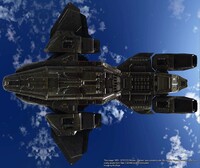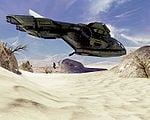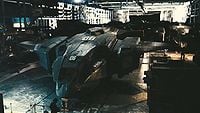D77H-TCI Pelican: Difference between revisions
From Halopedia, the Halo wiki
(→Trivia: Pelicans are not invincible to the Scarab. Trust me) |
m (→Trivia) |
||
| Line 75: | Line 75: | ||
==Trivia== | ==Trivia== | ||
*In the cockpit it has a screen which in Hocus' Pelican reads "connected to [[UNSCDF]] via local grid Pz87-3383" | *In the cockpit it has a screen which in Hocus' Pelican reads "connected to [[UNSCDF]] via local grid Pz87-3383." It also has the insignia of the UNSCDF in the upper left corner. This screen is also used as a method of communication in scripted sequences. | ||
*It is possible to kill the pilots in ''[[Halo 3]]'' by using a [[plasma grenade]] on [[Sierra 117 (Level)|Sierra 117]] , making it impossible to complete the level. | *It is possible to kill the pilots in ''[[Halo 3]]'' by using a [[plasma grenade]] on [[Sierra 117 (Level)|Sierra 117]] , making it impossible to complete the level. | ||
*Pelicans, unlike [[Type-52 Troop Carrier|Phantoms]] are invincible in-game, surviving direct hits from the weapons of everything from a [[Scorpion]] to a [[Scarab]]. The only exceptions to their invulnerability lay in the multiplayer map ''[[Rat's Nest]]'' where sprites in likeness of them can be destroyed by the [[Spartan Laser]], and the pelicans flying high above the citadel battle in The Covenant, which are supposed to be randomly destroyed, as well as several Pelicans seen getting destroyed in [[Metropolis (Level)]] by the [[Scarab]]. | *Pelicans, unlike [[Type-52 Troop Carrier|Phantoms]] are invincible in-game, surviving direct hits from the weapons of everything from a [[Scorpion]] to a [[Scarab]]. The only exceptions to their invulnerability lay in the multiplayer map ''[[Rat's Nest]]'' where sprites in likeness of them can be destroyed by the [[Spartan Laser]], and the pelicans flying high above the citadel battle in The Covenant, which are supposed to be randomly destroyed, as well as several Pelicans seen getting destroyed in [[Metropolis (Level)]] by the [[Scarab]]. | ||
Revision as of 16:18, September 5, 2009
The Dropship-77 Heavy Troop Carrier/Infantry Pelican, abbreviated D77H-TCI Pelican, is a newer model of the venerable D77-TC Pelican, recently introduced into service within the UNSC Marine Corps and Navy in late 2552 and early 2553.
Background
The D77H-TCI is a fleet wide upgrade to the UNSC's squadrons of Pelican dropships, that have been in service for over 50 years. First seen deployed in November, 2552 [1] the Pelican is the primary tactical support aircraft of the UNSC. The Pelican serves a multi-role purpose, it is fully capable of Atmospheric flight and can land almost anywhere without difficulty, the Pelican is also capable of limited spaceflight, making the pelican the prime troop transport of the UNSC. The D77H-TCI makes several drastic design changes to both the interior, and exterior, although the exteriors changes are not as noticeable as the interior is. The first significant change is in the cockpit area of the D77H which instead of having the pilot and co-pilot sitting next to each other, the copilot is now seated behind and above the pilot, the control's and instrument panels have been rearranged and upgraded for the D77H. A small holo-tank is installed in the cockpit, allowing an artificial intelligence to project its holographic form to the craft's pilots.[2]
Payload Capacity
The pressurized payload area has also seen a design change, the D77H-TCI variant of the Pelican carries the same number of passengers as its predecessor. However, its troop-bay is more flexible, able to carry up to two Mongoose ULATV's internally, in addition to ten passengers, also it has a hermetic door on its rear section for ship-to-shore orbital insertions. Its tail-mounted magnetic clamps are capable of carrying a M12 Warthog LRV, M12G1 Warthog LAAG or M831 TT Warthog, an M808B Scorpion MBT, or four Type C Resupply Capsules rather than six of the older Type B Resupply Capsules, to the battlefield, able to detach its payload without landing decreasing the chance of an attack while it unloads.
Armament
The D77H-TCI Pelican, like its predecessor, is compatible with the Rotary-cannons in both 40mm and 70mm types. The Pelican is also able to mount an AIE-486H Heavy Machine Gun in its troop-bay compartment for supporting ground teams and covering the departure of its passengers, an improvement from the previous M247 GPMG, although this prevents it from carrying a vehicle internally. The D77H can also be equipped with ANVIL-II ASM Pods; the design of the pods has changed, and now seamlessly blends with the Pelican. The new ANVIL pods can fire up to 12 missiles at once, six from each pod. A Gunship version of the D77H is in service as well, this heavily armed version, is equipped with more chainguns, missiles, and a large cannon, mounted at the ventral-fore of the dropship[3].
Propulsion
The main engines are mounted in pairs in four nacelles, one situated on each wing and two at the rear and posterior. The nacelles can articulate independently, thus altering the direction of thrust, referred to as vectoring in aviation; This improves the Pelican's low altitude maneuverability. Four ventral thrusters are identified by markings and a rendered thrust effect, one on each wing nacelle and one on each aft nacelle, allow the drop ship to land and take off vertically. These engines are capable of both space and atmospheric operation. It has 8 jet intakes, 3 on each side and 2 on top.
The wings mounted on a Pelican seem extremely small, too small to support the weight of drop ship and payload alone. It is speculated that it utilizes at least some Lifting Body principles, using its own hull create most of the lift necessary for flight. It may also be that the Pelican partially relies upon thrust vectoring, referred to as jet-borne flight as opposed to wing-borne flight which can be further reinforced with the fact that down-ward aiming jets can be seen on the bottom of the thruster mountings. It should be noted that small wings are very efficient for high-speed flight, as demonstrated by the F-104 Starfighter. It is also a benefit for operations in the upper atmosphere, especially re-entry, as was the case with the X-15. The D77H-TCI, like the D77, although fully capable of orbital insertion, is too small to be equipped with a Shaw-Fujikawa Translight Engine, and thus is incapable of slipspace travel.
Identified Pelicans
| |||||||||||||||||
Trivia
- In the cockpit it has a screen which in Hocus' Pelican reads "connected to UNSCDF via local grid Pz87-3383." It also has the insignia of the UNSCDF in the upper left corner. This screen is also used as a method of communication in scripted sequences.
- It is possible to kill the pilots in Halo 3 by using a plasma grenade on Sierra 117 , making it impossible to complete the level.
- Pelicans, unlike Phantoms are invincible in-game, surviving direct hits from the weapons of everything from a Scorpion to a Scarab. The only exceptions to their invulnerability lay in the multiplayer map Rat's Nest where sprites in likeness of them can be destroyed by the Spartan Laser, and the pelicans flying high above the citadel battle in The Covenant, which are supposed to be randomly destroyed, as well as several Pelicans seen getting destroyed in Metropolis (Level) by the Scarab.
Gallery
- 1210810634 Gfs 63166 2 16.jpg
A Pelican seen from the front, with ANVIL-II pods attached.
- 1212438981 The Pit.jpg
Pelicans outside The Pit.
- Pelican-Abrams Comparison.jpg
A comparison of how big the troop bay actually is.
- PolicePelican1.png
The NMPD-version of the D77H-TCI.
Sources
- ^ Halo: Ghosts of Onyx Chapter 23, Page 203
- ^ Halo 3
- ^ High Ground (Level) computers




